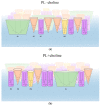Physicochemical Characteristics of Model Membranes Composed of Legionella gormanii Lipids
- PMID: 36984743
- PMCID: PMC10058700
- DOI: 10.3390/membranes13030356
Physicochemical Characteristics of Model Membranes Composed of Legionella gormanii Lipids
Abstract
Legionella gormanii is one of the species belonging to the genus Legionella, which causes atypical community-acquired pneumonia. The most important virulence factors that enable the bacteria to colonize the host organism are associated with the cell surface. Lipids building the cell envelope are crucial not only for the membrane integrity of L. gormanii but also by virtue of being a dynamic site of interactions between the pathogen and the metabolites supplied by its host. The utilization of exogenous choline by the Legionella species results in changes in the lipids' composition, which influences the physicochemical properties of the cell surface. The aim of this study was to characterize the interfacial properties of the phospholipids extracted from L. gormanii cultured with (PL+choline) and without exogenous choline (PL-choline). The Langmuir monolayer technique coupled with the surface potential (SPOT) sensor and the Brewster angle microscope (BAM) made it possible to prepare the lipid monomolecular films (model membranes) and study their properties at the liquid/air interface at 20 °C and 37 °C. The results indicate the effect of the choline addition to the bacterial medium on the properties of the L. gormanii phospholipid membranes. The differences were revealed in the organization of monolayers, their molecular packing and ordering, degree of condensation and changes in the components' miscibility. These findings are the basis for further research on the mechanisms of adaptation of this pathogen, which by changing the native composition and properties of lipids, bypasses the action of antimicrobial compounds and avoids the host immune attack.
Keywords: Langmuir monolayer technique; Legionella gormanii; phospholipids.
Conflict of interest statement
The authors declare no conflict of interest.
Figures






References
-
- Ephros M., Engelhard D., Maayan S., Bercovier H., Avital A., Yatsiv I. L. gormanii pneumonia in a child with chronic granulomatous disease. Pediatr. Infect. Dis. J. 1989;8:726–727. - PubMed
-
- Lei C., Zhou X., Ding S., Xu Y., Yang B., Guo W., Song M., Yang M., Jia Y., Luo H. Case Report: Community-acquired Legionella gormanii pneumonia in an immunocompetent patient detected by metagenomic next-generation sequencing. Front. Med. 2022;9:61. doi: 10.3389/fmed.2022.819425. - DOI - PMC - PubMed
-
- Bender J., Rydzewski K., Broich M., Schunder E., Heuner K., Flieger A. Phospholipase PlaB of Legionella pneumophila represents a novel lipase family: Protein residues essential for lipolytic activity, substrate specificity, and hemolysis. J. Biol. Chem. 2009;284:27185–27194. doi: 10.1074/jbc.M109.026021. - DOI - PMC - PubMed
LinkOut - more resources
Full Text Sources
Molecular Biology Databases
Miscellaneous

